1. Features, specs
We have in our labs OCZ' s latest SATA solid state drive, the Vector 256GB SSD. The Vector SSD Series is featuring the company’s next-generation Indilinx Barefoot 3 controller and promises to provide exceptional input/output operations per second (IOPS) performance over time regardless of whether the data streams are in compressed or uncompressed formats.
The Vector SSD Series is available in 128GB, 256GB and 512GB capacities, and delivers read bandwidth of up to 550 MB/s, write bandwidth of up to 530 MB/s, random read performance of up to 100,000 IOPS.
It's slim, 7mm housing supports a wide spectrum of computers including the latest thin form factor notebooks, and each Vector SSD is also bundled with a 3.5-inch desktop adapter bracket and Acronis True Image cloning software.
The Barefoot 3 controller also includes a suite of flash management tools that can analyze and dynamically adapt to increasing NAND vulnerabilities as flash cells wear or process geometries get smaller. According to OCZ, this means that the Barefoot 3 controller overcomes the shortcomings associated with MLC NAND flash memory and is specified to deliver 20GB host writes per day for 5 years.

| PERFORMANCE |
128GB |
256GB |
512GB |
| Sequential Reads1 |
550MB/s |
550MB/s |
550MB/s |
| Sequential Writes1 |
400MB/s |
530MB/s |
530MB/s |
| Random 4k Read IOPS2 |
90,000 IOPS |
100,000 IOPS |
100,000 IOPS |
| Random 4k Write IOPS2 |
95,000 IOPS |
95,000 IOPS |
95,000 IOPS |
1. Maximum sequential speeds are determined using ATTO
2. Small file I/O performance is measured using Crystal Disk Mark, 1000MB test file size, QD32 |
| PHYSICAL |
| Usable Capacities (IDEMA) |
128GB, 256GB, 512GB |
| NAND Components |
25nm Multi-Level Cell (MLC) |
| NAND Controller |
Indilinx Barefoot 3 |
| Interface |
SATA 3 6Gb/s |
| Form Factor |
2.5 Inch, Ultra-slim 7mm |
| Dimension (L x W x H) |
99.7 x 69.75 x 7mm |
| Weight |
115g |
| RELIABILITY / PROTECTION |
| MTBF |
1.3 million hours |
| Data Path Protection |
BCH ECC corrects up to 28 random bits/1KB |
| Data Encryption |
256-bit AES-compliant, ATA Security Mode Features |
| Product Health Monitoring |
Self-Monitoring, Analysis and Reporting Technology (SMART) support |
| ENVIRONMENTAL |
| Power Consumption |
Idle: 0.9W, Active: 2.25W |
| Operating Temperature |
0°C ~ 55°C |
| Storage Temperature |
-45°C ~ 85°C |
| Shock Resistance |
1500G/0.5ms |
| Certifications |
RoHS, CE, FCC |
| COMPATABILITY |
| Serial ATA (SATA) |
Fully compliant with Serial ATA International
Organization: Serial ATA Revision 3.0. Fully compliant with ATA/ATAPI-8
Standard Native Command Queuing (NCQ) |
| Operating System |
Windows / Mac OS X / Linux |
| ADDITIONAL FEATURES |
| Performance Optimization |
TRIM, Idle Time Garbage Collection |
| Endurance |
Rated for 20GB/day of host writes for 5 years under typical client workloads |
| Service & Support |
5-Year Warranty, Toll-Free Tech Support, 24 Hour Forum Support, Firmware Updates |
| Included Accessories |
Acronis True Image HD cloning software registration key (current version compatible with Windows XP, Vista and 7.) and a 3.5" desktop adapter |
|
PART NUMBER |
UPC |
| 128GB |
VTR1-25SAT3-128G |
842024033004 |
| 256GB |
VTR1-25SAT3-256G |
842024032342 |
| 512GB |
VTR1-25SAT3-512G |
842024032335 |
2. The package
The Vector 256GB retail package is shown below:
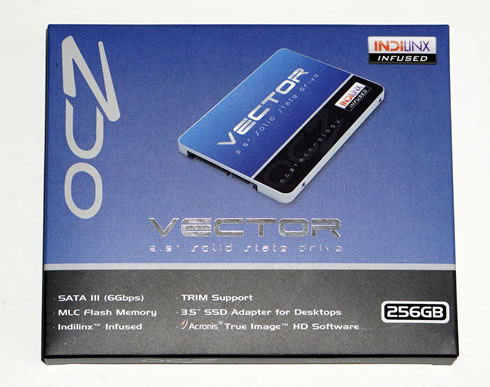
The package includes the OCZ Vector SSD, a 2.5 inch to 3.5 inch converter bracket, fixing screws, the quick start booklet and finally a serial key for Acronis True Image HD cloning software.


The drive itself has a a brand new 7mm chassis. The aluminum colored enclosure features a new label:
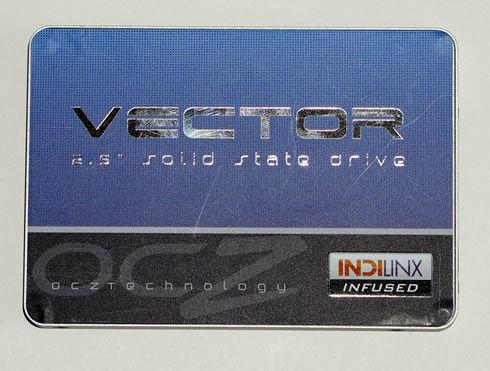
The bottom of the SSD looks familiar as the name, part number and other details are laid out in traditional OCZ fashion:
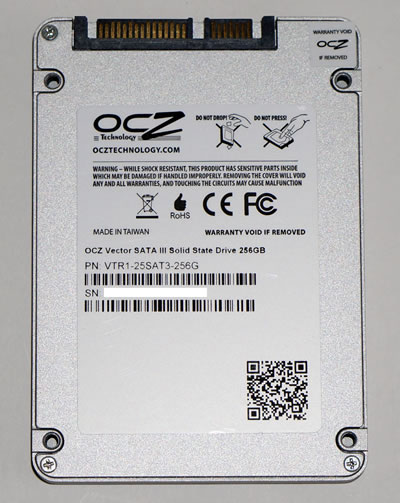
Under the hood the drive is all new. Vector uses the first home-grown SSD controller by OCZ. It is true that both the OCZ Octane and Vertex 4 SSDs used OCZ Indilinx branded silicon, but those were based on Marvell IP. Vector on the other hand uses OCZ's brand new Barefoot 3 controller, designed entirely in-house.
Below you see eight 25nm IMFT synchronous 2-bit-per-cell MLC NAND positioned on the PCB, along with the new Indilinx BareFoot 3 SSD controller, DDR3 cache memory, and various support components.

The controller integrates an ARM Cortex core as well as an OCZ co-processor. Architecturally, Barefoot 3 can talk to NAND across 8 parallel channels. The controller is paired with two DDR3L-1600 DRAMs.

The drive came with firmware Ver. 1.03.1 installed and as you see below, the available capacity for the consumer is 244.198MB:



3. HDTachRW
Here is our testbed:
- Motherboard: Foxconn Quantum Force Rattler P67 vP04 BIOS
- Processor: Intel Core i5-2500K
- Case: Open Air testbed
- Power Supply Unit: Club 3D CSP-X1000CB 1000 Watt
- Graphics card: Club3D Radeon HD 6790 CoolStream Edition
- Memory: OCZ Gold PC3-10600 4x2GB 1333@CL9
- HDD: WD 500GB 7200RPM
- Monitor: LG L246WH-BH 24"
- Windows 7 x64 SP1 with latest updates installed
For the tests, we used the following software:
- HDTachRW v3.0.1.0
- HD Tune v4.50 Pro
- Crystal DiskMark v3
- ATTO Disk Benchmark v2.46
- ASS SSD Benchmark 1.5xxx
- IOMeter v2006.07.27 with Xtreme Benchmark template
- PCMark Professional edition v1.04
- Anvil Storage Utilities 1.0.34. Beta 11
We start the tests with the HDTachRW software. It shows the potential read speed which you are likely to experience with the SSD.
The software measures the sequential read speed, the random access speed and sequential write speed.
The reported average sequential writing speed was 394.6 MB/s and the average sequential reading of 393.5 MB/s are lower than the figures quoted by OCZ and slightly lower than some other SSDs:
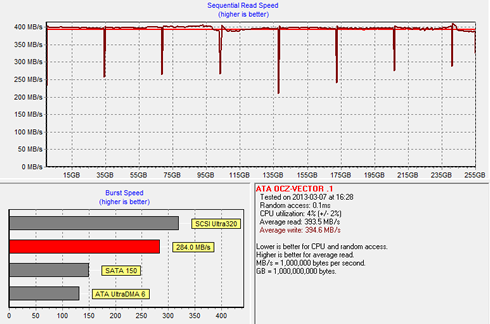
We move on to the HD Tune Pro software, another utility we used to measure the drive's reading and writing performances. Although not necessarily representative of real-world workloads, HD Tune's targeted tests give us a glimpse of each drive's raw capabilities.
The sequential reading test returned a 370.9 MB/s average speed. Writing was slower at 328.6 MB/s average:
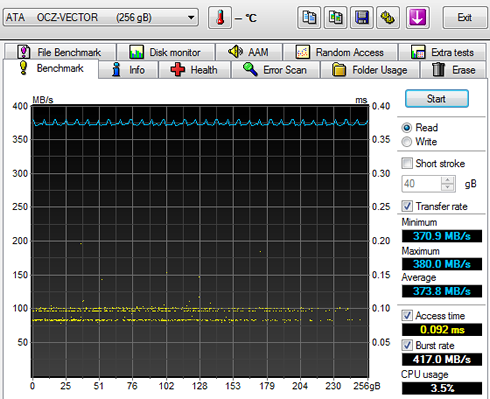
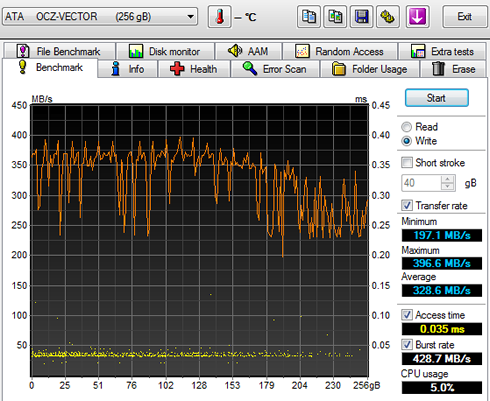


4. ATTO Disk Benchmark
The next software we used was the ATTO Disk Benchmark. The tool measures storage systems performance with various transfer sizes and test lengths for reads and writes. The benchmark performs file transfers ranging from 0.5 KB to 8192 KB. ATTO can be adjusted to do overlapped I/O, in a variety of queue depths. We tested the SSD using the benchmark's default settings, using 256KB file length performance and QD4. ATTO probably gives the most accurate results for compressible read and write data.
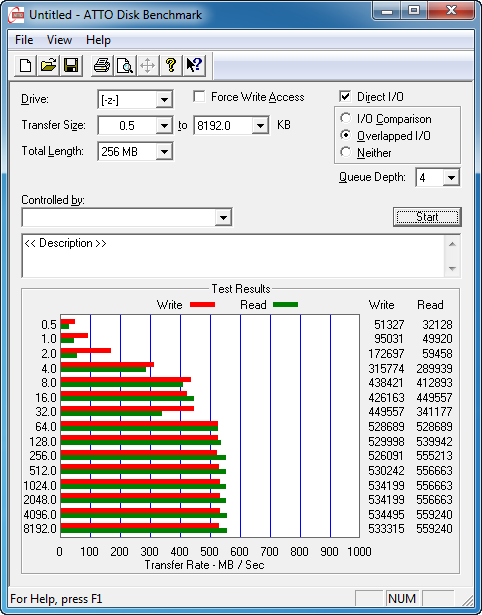
In the write test, the OCZ Vector 256GB SSD reached over 530MB/s with block sizes larger than 512 KB. Reading was even faster at around 550 - 560 MB/s , again with 522KB or larger files. That's a great performance for the drive and very close to what we expected to see after reading OCZ's official specs.
The drive's strengths are easily identified in the following graphs, which show its performance with small 4K files and large 2MB files, in both read and write operations.
Reading of 4K files was awesome at 289.9 MB/s, with the Vector drive to easily reach the top of the SSDs we have tested so far. Writing of such small 4K (compressible) files was also very fast (315.7MB/s) - a performance close to what we had measured with a Vertex 4 and Agility 4 SSDs:
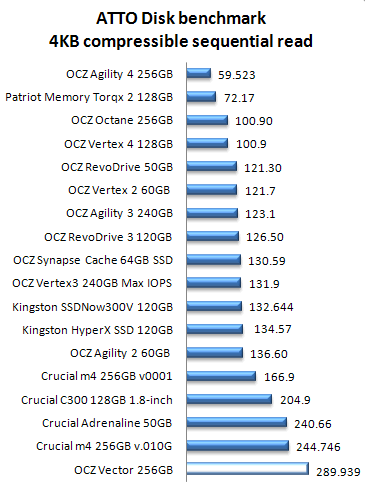
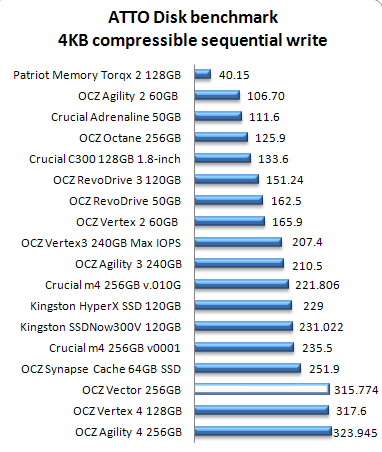
Going further to larger file transfers, the Vector 256GB SSD is among the fastest you can find for both reading and writing, effectively competing with Kingston's SSD (read, write) and the Vertex 4 (write):
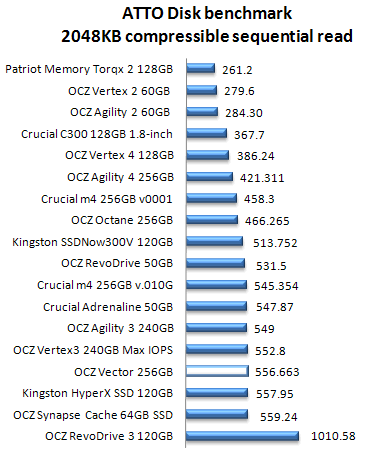

5. CrystalDiskMark
The next benchmark is the CrystalDiskMark. The software provides throughput data based on sequential reads and writes, and random (512K/4K/4KQD32) reads and writes of various sizes.
Below you see the drive's performance with compressible data:

As we previously saw, the OCZ Vector 256GB SSD is very fast in the sequential reading and writing tasks with compressible data. The drive reads and writes smaller files (512K and 4K) faster than competition, but is shows its real strength when queue depths increase:

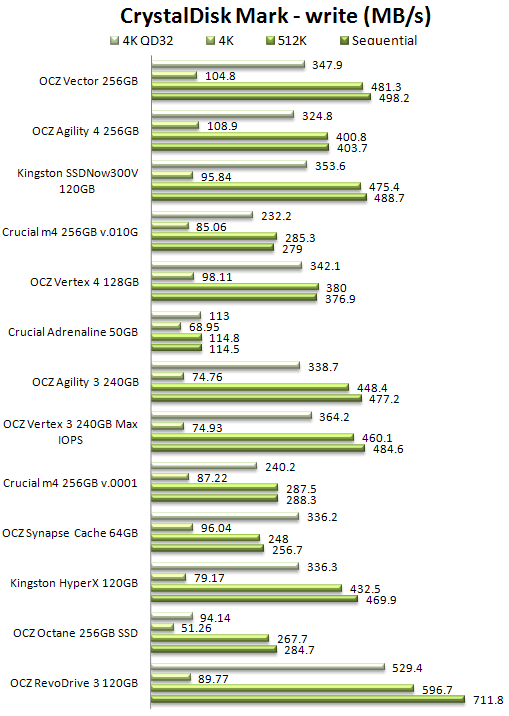
6. AS SSD benchmark
We proceed with the AS SSD benchmark, which contains five synthetic as well as three practical tests. The synthetic tests determine the sequential and the random read / write performance of an SSD. These tests are carried out without using the operating system's cache. The Seq-test measures how long it takes to read and write an 1GB file. Most importantly, this sequential benchmark uses incompressible data for all of its transfers.
The 4K benchmark tests the read and write performance for random 4K blocks. The 4K-64-THRD-test corresponds to the 4K procedure except that here the read and write operations are distributed on 64 threads:
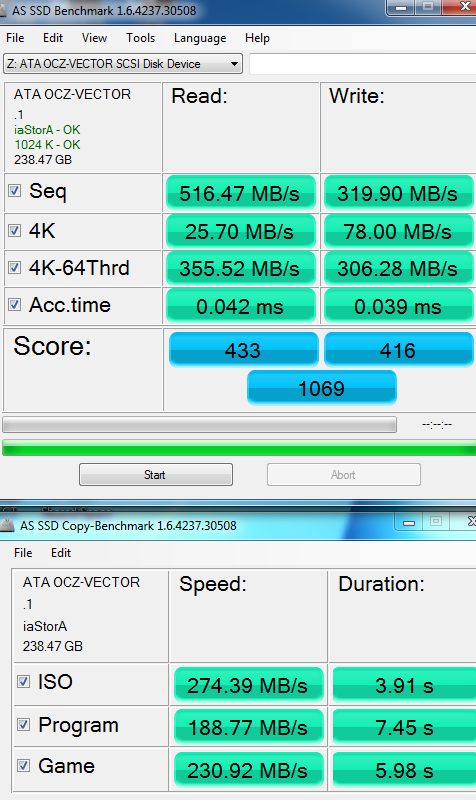
The Vector's performance in sequential reading with incompressible data was great (516.47 MB/s), ranking first in the graph you see below. Sequential writing was also fast but slower that the Vertex 4 and the Agility 4 SSDs:


At the 4K random reading tests, the Vector took the second place in the rank with a very high 25.7 MB/s:
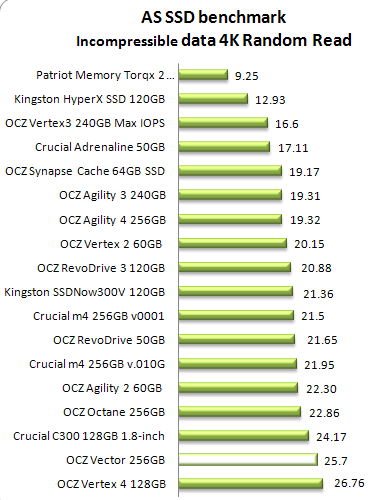
The drive was also fast in 4K random writing tests with 78MB/s:

Multithreaded requests for random reading of 4K incompressible files are always more demanding for SSDs. However, the Vector drive excels and easily ranks first in the charts below, in both read and write tests:


In the following graph you see how the OCZ Vector 256GB drive reads and writes files, which have been partially of fully compressed. It is obvious that the drive's reading and writing performance is steady with all kind of data:
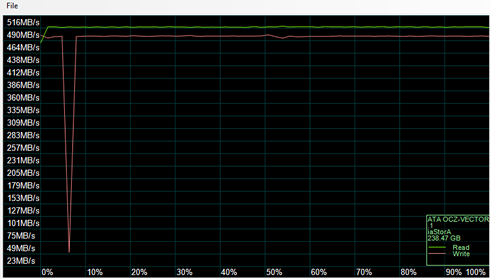
7. IOMeter benchmark
We proceed to IOMeter benchmark. Iometer is run by using workstation and database patterns for queue depths (outstanding I/Os) representing very light and moderate loads. Iometer is both a workload generator (that is, it performs I/O operations in order to stress the system) and a measurement tool (that is, it examines and records the performance of its I/O operations and their impact on the system). The app's ability to bombard drives with an escalating number of concurrent IO requests also does a nice job of simulating the sort of demanding multi-user environments that are common in enterprise applications. The software can be used for measurement of the performance of an SSD. We started using the IOMeter tests using the Xtreme Benchmark template .

For the specific test, we used 100% random, 67%-33% Read/write distribution, aligned with the benchmarks we had already done in the past with other SSDs.
It looks like the Vector 256GB SSD has no direct opponents here as it gave the highest IOPS we have seen so far from an SSD, in both writing and reading tests:

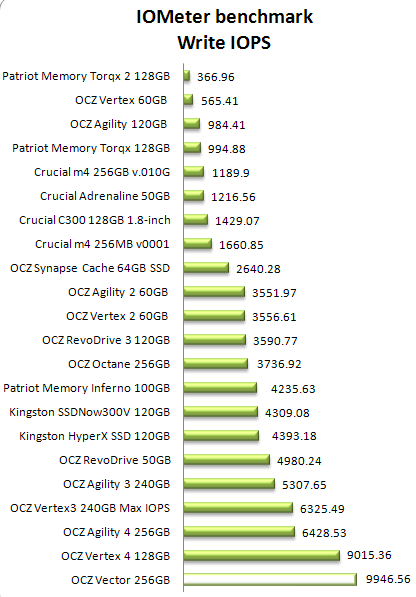

8. Anvil Pro SSD Benchmark
The next benchmark is the Anvil Pro, an ‘all inclusive’ storage utility. The software is tests transfer speeds as well as IOPS The IOPS tests can be configurable with preset testing scenarios for read (Seq 4MB, 4K, 4K QD4, 4K QD16, 32K and 128K), write (Seq 4MB, 4K, 4K QD4, 4K QD16) and mixed IO.
We used the software with the Vertex 4 128GB SSD and tested the drive with 0-fill compression (RAW), 8% compression, 25% compression, 45% compression, 67% compression and finally 100 % (incompressible data). Below are the results:


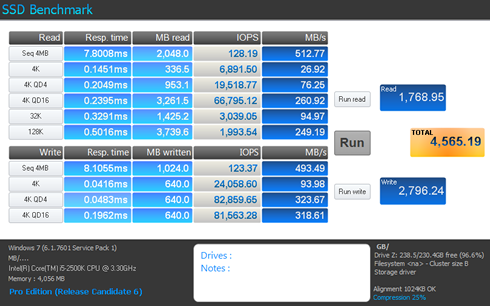



In the following charts we illustrate the results we got from four different drives with 0-fill compression as well as with incompressible files.

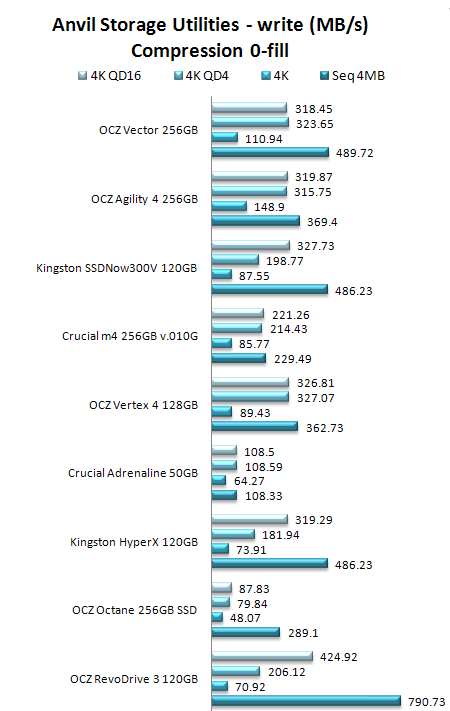
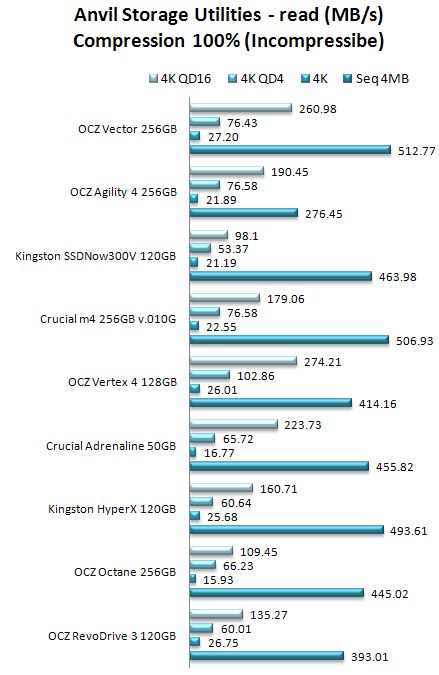

9. PCMark 7 Professional
Below you see the results of Futuremark's PCMark 7 Professional edition. The software includes 7 PC tests for Windows 7, combining more than 25 individual workloads.
The OCZ Vector 256GB SSD scored 5458 points and has the lead in the test among the SSDs we have tested so far.

Below you can see the breakdown of individual benchmarks with the testing methodology. The Vector SSD maintained the highest performances in the corresponding sub-tests:
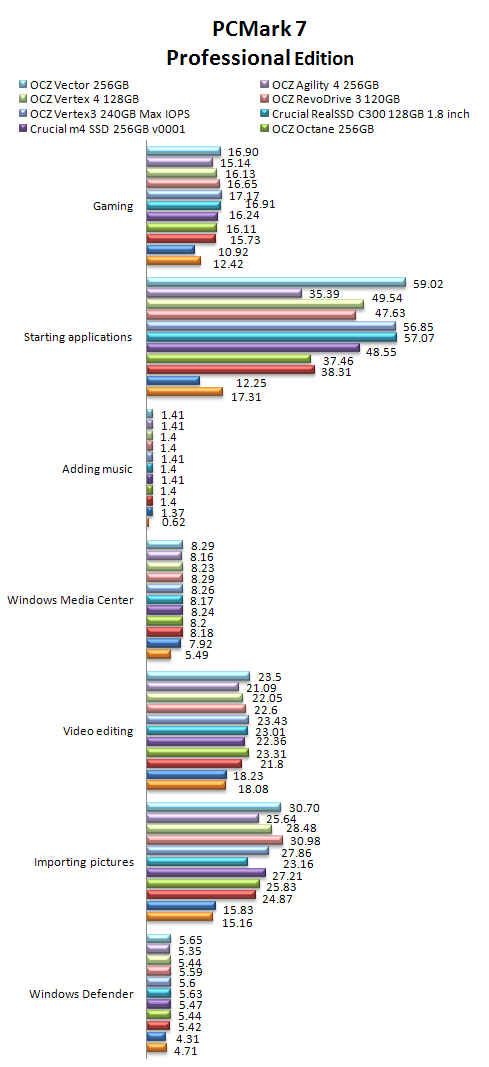
10. Summary
OCZ has made a great job with the design and optimization of the Barefoot 3 controller. It provides a really consistent performance with all kind of files - no matter they are small, large, compressible or not.
The Vector SSD excelled in almost any test we put it through: it offered fast sequential read/write speeds, great performance with small file threaded requests, very fast performance with
small random files and high queue depths as well as low access times. Adding to all these a 5-year warranty and you have possibly the best SATA SSD made so far.
Overall we are impressed by the Vector, as it proved to be a solid step forward for OCZ compared to the Vertex 4, highly competitive to other high-performing SSDs such as Samsung's offerings and still, very reliable and stable during operation.
The 256GB drive retails for $250, which is $10 more than the Samsung 840 256GB PRo Series. Don't forget that you are still apply for a free downloadable OCZ's Far Cry3 game PC game with each purchase of a Vector SSD.
Positive:
- Stable operation under a heavy workload
- Very high sequential reading and writing performance, even at very low queue depths.
- Great 4K random writing performance regardless queue depths
- Excellent 4K random reading performance regardless queue depths
- SATA 6Gbps support
- TRIM support under Windows 7 and Windows 8
- Low access times
- 5 year warranty
Negative:
- Price could be a little lower